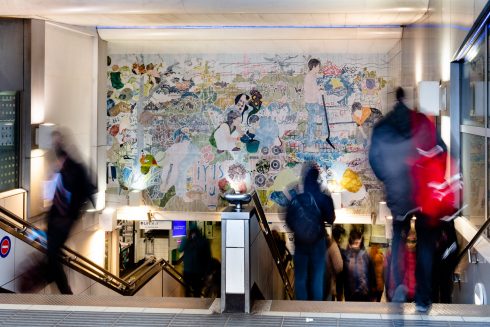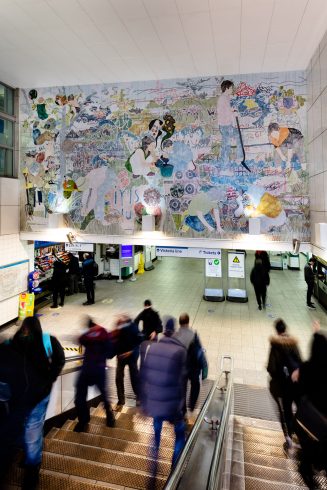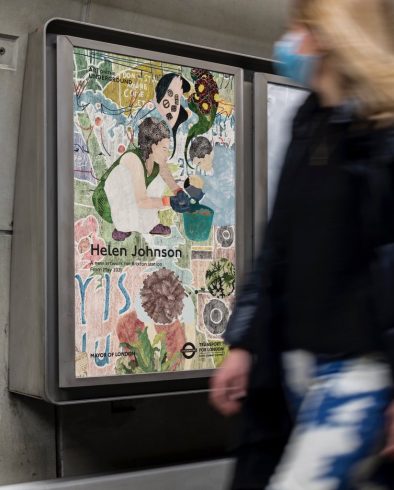Art on the Underground present Things Held Fast, a new large-scale public commission at Brixton Underground station by Australian artist Helen Johnson, on view from 20 May – November 2021. For her first major public commission, Johnson represents Brixton through the lens of a community garden – a shared space of growth that builds over time due to collective commitment.
Johnson’s is the fourth in a series of commissions at Brixton station, following on from Denzil Forrester, Aliza Nisenbaum and Njideka Akunyili Crosby. The programme invites artists to respond to the diverse narratives of the local murals painted in the 1980s, the rapid development of the area and the wider social and political history of mural making.
For her new commission, Things Held Fast, Johnson depicts a group of figures gardening, absorbed in their tasks and conversation and connected by the investment of their shared energies in a communal space. Much of the painting’s imagery is drawn from the Lambeth Archives, which provided insight into organisations, projects and movements that underlie the community at the heart of Brixton. For example, the owl depicted is taken from a protest banner to save Lambeth libraries, children are shown climbing a cherry blossom tree, referencing the Cherry Tree childcare centre that was closed amidst much local protest, and the whirligig beetle and pondlife depicted can all be found in nearby Myatt’s Fields. The painting’s vignettes are signifiers of history, growing and interconnected like plants in the soil. They are represented in fragments and details, but tell the stories of community organisations and movements such as the Lambeth Women’s Project; anti-racist organisations like Unity Centre; gardening groups like the one at Myatt’s Fields Park; or the movement to save local libraries.
Johnson’s commission also explores a common theme in the artist’s practice, the construction of national identity and the legacies of colonisation. Embedded in the layered surface of Things Held Fast, is an image derived from Robert Dodd’s engraving Mutiny on the Bounty (1790), which depicts mutineers ejecting Vice-Admiral William Bligh from his ship. The mutiny took place on a journey to transplant breadfruit trees from Tahiti to the Caribbean as a food source for the enslaved people who were there under British colonial rule. Subsequently, William Bligh was appointed as Governor to the British colony of New South Wales, where he oversaw the dispossession of indigenous peoples and unspeakable violence towards them. Bligh, a resident of Lambeth between 1754-1817, became a negative connection for the artist to Brixton. As a white artist living in Australia, Johnson wanted to acknowledge this colonial history and represent the opposing trajectories of Bligh, who travelled to the Caribbean for purposes of subjugation and dispossession; and the African and Caribbean communities who many years later established themselves in the UK, where, up against hostility and socio-economic inequalities, they continued to foster solidarity and cultivate strong communities.
Research for Things Held Fast began in late 2019 at a moment when Australia was ravaged by one of the worst bushfires in its history. For Johnson, the loss caused by the fires gave rise to appreciation of what remained and what is valuable. The commission was painted in Melbourne, in lockdown during the Covid-19 pandemic; this second challenging context served as a reminder to the artist that community is vital for our sense of collective purpose and wellbeing.
Things Held Fast represents multiple stories, densely layered, that will reveal themselves gradually over time. It does not take a single history or movement as its subject, but rather is a vehicle for thinking about how a multitude of narratives can lay the foundation for something greater.
Helen Johnson’s large-scale figurative paintings interlace her personal experiences with broader socio-cultural and historical observations. Her works are densely built-up, inviting the viewer to discover layers of intricate colour and pattern that were once stand-alone images. She creates surface texture by pressing materials into her paint, and through this process of layering obscures some depictions entirely. With both form and content, Johnson explores how histories are constructed, and how some narratives are privileged whilst others are concealed.
Helen Johnson, Artist, said: “The past year has been brutal, but has also served as a reminder that community is vital for our sense of collective purpose and wellbeing. Mindful that some people will walk by this work many times as their daily routines take them through Brixton Station, I sought to ground it in optimism, giving it the form of a community garden – a shared space of growth that builds over time – and filling it with detail and referential fragments such that it might offer something hitherto unnoticed with each encounter. For thinking about how a multitude of connections and energies can feed into something greater than the sum of its parts; hence again the metaphorical garden, and its associations of nourishment, and continuity through endings becoming beginnings.”
Eleanor Pinfield, Head of Art on the Underground, stated: “Helen Johnson continues Art on the Underground’s exploration of contemporary responses to muralism for Brixton station. This new work is extraordinarily timely; the metaphor of a community garden represents collective endeavour and resilience after a year like no other. Johnson’s work traces the legacies of colonialism and the history of community activism and mural making – bringing these complex themes together in a powerful and hopeful work that will be enjoyed by the millions of people using the station.”






